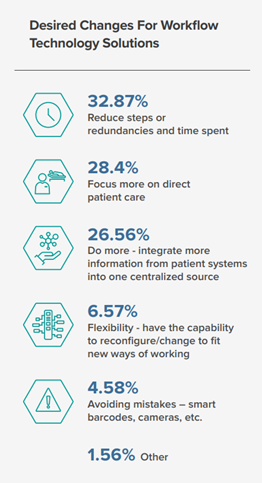We’re in a period of tech advancement that the World Economic Forum has dubbed the Fourth Industrial Revolution. Characterized by physical, digital, and biological worlds coming together, this period is one where tech enablement is a given, allowing us to shift our focus to finetuning the application of converging technologies.
In the Forward of “Nursing Satisfaction: What Matters Most at Work,” Ascom North America Managing Director Kelly Feist points to healthcare as a key market where you can see this revolution unfolding. Comfort with technology in healthcare picked up significantly after the pandemic, leading providers to rethink traditional care models through a new lens of digital empowerment. Today, the integration of connected devices, remote support, and AI into clinical workflows is forever changing how medical teams deliver care.
As Feist sees it, intelligent workflow technologies are more essential than ever in healthcare, due in large part to rising pressure on bedside nurses. In the Ascom nursing satisfaction survey, nurses cited increased patient loads, having to care for sicker patients, and working longer hours as drawbacks driving them away from the profession.
So, what can hospitals and health systems do to improve nurse satisfaction and retention?
Ascom notes that nurses are looking for value-adds that make the job worth doing. “This expectation can come in the form of traditional benefits like higher compensation as well as softer benefits, like greater flexibility in working hours and having mechanisms in place to make their job easier by delivering care more intelligently, efficiently, and collaboratively.”
Naturally, nurses want to be paid more for intensifying workloads, but technology is also influential in the fight for nurse talent. Almost 60% of nurses surveyed said that a hospital’s suite of technology tools was an important factor in deciding whether to take a job. Nurses want technologies to drive efficiency, give them more time with patients, and automate the capture of information into a centralized source.

Feist highlights three takeaways from the report:
1 – Technology designed for clinical workflows consistently ranks high for addressing some of the key challenges nurses identify as negatives in their jobs. Nurses’ number one desire for workflow solutions was to eliminate redundant steps.
“Ascom identified that nurses, nurse assistants, or technicians manually measure as many as four to six vital signs per round, record each result on a chart, and then enter all of the data into the electronic health record (EHR), which could take up to three hours per shift.”
Thus the rising popularity of aware rooms and Virtual Nursing. These next-generation solutions allow bedside RNs to shift routine tasks like admissions and vitals capture to integrated devices and remote team members.
2 – Technology is increasing the time nurses directly spend with patients. The automation and remote redistribution of routine tasks are freeing up time for bedside nurses to focus on what matters to them – patient engagement.
Interestingly, virtual patient engagement channels are also offering nurses new ways to build uninterrupted relationships with patients, and supporting career extension for older, experienced nurses to continue providing patient and staff support.
3 – Technology can aid in proactive care, giving clinicians a practice “safety net” to anticipate, recognize, and intervene before a sentinel event occurs. By augmenting patient coverage with virtual eyes, ears, and sensors, care teams are alerted to potential health threats earlier, improving downstream outcomes.
The ability to manage alerts to mitigate alarm fatigue and highlight actionable cues in the ocean of new information that providers are inheriting is becoming more important.
Today, technology plays a crucial role in supporting caregivers’ ability to provide the best patient care possible. With sicker patients seeking care, limited clinician pools, and a pending surge in elderly patient populations, empowering nurses with intelligent workflow solutions not only improves nurse satisfaction today, it also modernizes care models to ensure success in the future landscape of care delivery.









